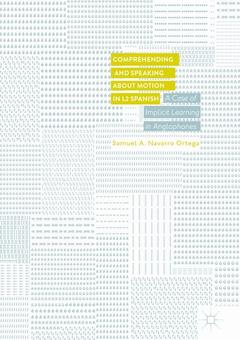Description
Comprehending and Speaking about Motion in L2 Spanish, 1st ed. 2017
A Case of Implicit Learning in Anglophones
Author: Navarro Ortega Samuel A.
Language: English
Subject for Comprehending and Speaking about Motion in L2 Spanish:
52.74 €
In Print (Delivery period: 15 days).
Add to cart
Comprehending and Speaking about Motion in L2 Spanish
Publication date: 02-2017
Support: Print on demand
Publication date: 02-2017
Support: Print on demand
Approximative price 52.74 €
In Print (Delivery period: 15 days).
Add to cart
Comprehending and Speaking about Motion in L2 Spanish
Publication date: 06-2018
Support: Print on demand
Publication date: 06-2018
Support: Print on demand
Description
/li>Contents
/li>Biography
/li>Comment
/li>
This book presents a novel analysis of the learning of motion event descriptions by Anglophone students of Spanish. The author examines cross-linguistic differences between English and Spanish, focusing on the verbal patterns of motion events, to explore how learners overcome an entrenched first-language preference to move toward the lexicalization pattern of the additional language. His findings highlight the gradual nonlinear process Anglophones traverse to acquire and produce form-meaning mappings describing motion in Spanish. The author suggests that as motion event descriptions are not normally the focus of explicit instruction, students learn this concept primarily from exposure to Spanish. Given its interdisciplinary nature, this book will be of interest to researchers working in Hispanic linguistics, cognitive semantics, and Spanish language learning and teaching.
- Chapter 1: Introduction.- Chapter 2: The linguistic expression of motion in language.- Chapter 3: Motion event descriptions a recurrent topic in Spanish discourse.- Chapter 4: Motion events in the speech + gesture interface.- Chapter 5: Investigating learner sensitivity to the path conflation in L2 Spanish.- Chapter 6: Sensitivity to the path conflation in written L2 Spanish.- Chapter 7: Sensitivity to the path conflation in oral L2 Spanish.- Chapter 8: Conclusion.
Samuel A. Navarro Ortega is Assistant Professor at the University of British Columbia, Canada.
Demonstrates how subtle aspects of Spanish can successfully be learned in the absence of direct teacher instruction Contributes to an under-researched area in cognitive semantics that crosses into the field of language teaching and learning Connects theoretical issues about the comprehension and expression of a conceptual category by Anglophone learners at three distinct levels of L2 proficiency
© 2024 LAVOISIER S.A.S.

